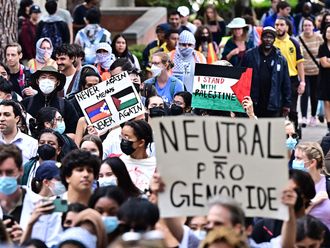For me, the most poignant photograph of the destruction left by Hurricane Sandy was of the Fairway supermarket in Red Hook, Brooklyn. I used to shop there on weekends and, in the cafe at the back, next to two disused trams, would enjoy the vista of New York harbour and the Statue of Liberty.
Watching the spirited New York response — Mayor Michael Bloomberg and his sign-language interpreter, babies being ferried out of New York University hospital, locals braving the blackout on the Lower East Side, pledges to drain the flooded subways — it is easy to underestimate the longer-term calamity. Hurricanes do not keep engulfing New York. This should not be happening.
But Sandy has happened, only a year after Irene blew past, and the signs are that it will occur again — and again. The financial and business hub of the world’s biggest economy will again be tossed around and flooded — its stock exchanges closed and its citizens sheltering in apartments without power. Next time, it might be worse.
The irony is that New York was once a dystopian metropolis because of the people who lived there — the gangs and hustlers left by middle-class flight to the suburbs. Now it has been so thoroughly cleaned that the suburbs are fading as the well-off settle in Soho, Tribeca and Brooklyn. It is one of the most civilised, least dangerous of US cities — except for a change in the climate.
It is not alone, although it is the starkest example. All over the world, from London to Shanghai and Hong Kong, people flood to coastal cities that generate jobs and are centres of innovation, economic dynamism and culture. This human flood confronts a real one, brought on by higher and warmer oceans.
When I was a child in the 1960s, I stood on our garden path in Kew, watching the flood waters from a tidal surge in the Thames flow along the road to within inches of us. The authorities reinforced the river bank and later constructed the Thames Barrier at Woolwich to stop the floods from occurring. That is what we expect: infrastructure and technology that keeps citizens shielded from natural forces. The ascent of the modern city, where people live, work and socialise cheek by jowl, was enabled in London by Joseph Bazalgette’s building of the Victorian sewer system, killing off cholera.
New York’s infrastructure is even more monumental - the Brooklyn Bridge, built in 1883 and the deluged Brooklyn-Battery Tunnel (jarringly renamed after Hugh Carey, the New York governor who started to untangle the financial and social chaos of the 1970s) in 1950. But none is immune to a hurricane.
The Achilles heel of these great port cities is being built by water, and New York’s vulnerability is more acute than most. Manhattan is an island; Brooklyn and Queens are on the edge of Long Island and Staten Island speaks for itself. New Orleans could raise its levees, and London could dam its river. New York is surrounded.
It is steadily becoming more vulnerable to the tides. Of the top 10 high-water marks at the Battery on the southern end of Manhattan since 1900, three have occurred in the past two years — Irene, Sandy and the 2010 spring flood. Flood surges around the edge of lower Manhattan are now familiar events.
Hurricanes traditionally wore out before reaching the northeast coast, with rare exceptions such as the Long Island Express hurricane of 1938. Tropical storms starting off by the Gulf of Mexico or, in the case of Sandy, Venezuela, tended to lose energy and fizzle out when they hit the cold northern ocean.
This is changing. Parts of the Atlantic Ocean were several degrees warmer than usual this year, which helped to propel Sandy up the coast until it folded into another north-eastern storm, bounced off a weather front encouraged by melting Arctic ice and battered Atlantic City and the New Jersey Shore.
“Sandy is a clear case of us being very unlucky but climate change contributed to it in a variety of ways and it is continuing to load the dice against us,” says Ben Strauss, who leads the Sea Level Rise programme at Climate Central, a research group in New York.
The drenching of Atlantic City is sad but, in economic terms, New York matters more. In many ways, it is the quintessential city: tightly-packed, easy to get around (thanks to dense public transport) and full of technology and services. It is a bundle of energy, drawing in migrants from less vibrant parts of the US and immigrants.
Such cities dominate national economies. The McKinsey Global Institute estimates that 60 per cent of the rise in global GDP between 2010 and 2025 will come from 600 cities. Having emerged from its past days of decline, New York is well-placed to lead this trend, apart from its geographical weakness.
New York has no obvious solution. Shifting buildings and citizens away from the low-lying areas would be impossible (imagine the reaction of Red Hook dwellers to being told to move to Park Slope) and building barriers across rivers would be expensive and imperfect.
Rivals may spy opportunity in the city’s travails — some will drop hints to employers and exchanges that they ought to move somewhere safer and dryer. But New York is not the only large metropolis perched by the coast or a tidal harbour. We are witnessing the future.
— Financial Times












